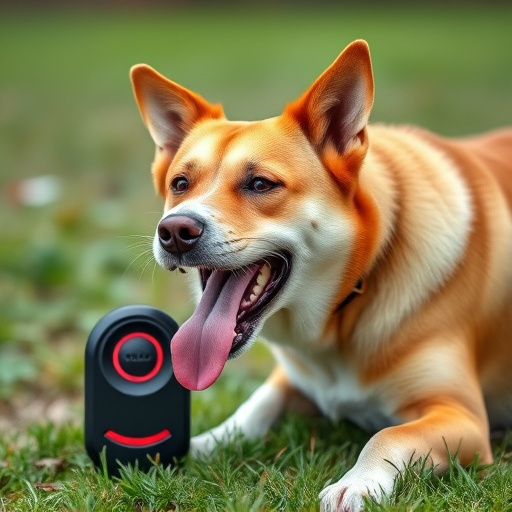Sonic dog repellers, high-frequency sound wave devices, protect gardens, patios, and indoor spaces from stray dogs. They are easy to install, adaptable to various locations, and offer adjustable frequency settings. The optimal frequency range is 3-15 kHz, inaudible to humans but startling to dogs. For best results, mount them at eye level or slightly elevated in areas dogs frequently enter, like gardens or patios, using line-of-sight placement. Regular cleaning, inspection, and testing of sensitivity settings ensure effective protection without disturbing others.
Distract and repel dogs from unwanted areas with a sonic dog repeller, an innovative solution for property owners. This article guides you through mastering the art of keeping dogs at bay. Learn about the science behind sonic technology and its effectiveness in different frequencies. Discover the ideal installation spots to maximize results, whether it’s your garden, patio, or even a farm. We’ll also cover maintenance tips and safety measures to ensure a harmonious coexistence with both pets and unwanted visitors. Find out where to strategically place your sonic dog repeller for optimal protection.
- Understanding Sonic Dog Repellers: How They Work
- Determining the Optimal Frequency Range
- Choosing the Right Installation Location
- Maintenance and Safety Tips for Effective Use
Understanding Sonic Dog Repellers: How They Work
Sonic dog repellers are innovative devices designed to deter dogs from entering or disturbing specific areas using high-frequency sound waves. Unlike traditional repellents that rely on spray or taste inhibitors, sonic repellers emit a range of ultrasonic frequencies—beyond human hearing but unpleasant to canine ears. This technology is particularly useful for homeowners looking to protect their gardens, patios, or even indoor spaces from unwelcome dog visits.
The installation process for a sonic dog repeller is straightforward and adaptable to various settings. They can be strategically placed in your yard, on balconies, or even indoors near problem areas. Some models offer adjustable frequency settings, allowing you to customize the range to target specific breeds or sensitivity levels. Proper placement ensures that the device’s sound reaches the intended space effectively, creating a comfortable yet unwelcome environment for stray dogs while preserving peaceful coexistence with nearby pets.
Determining the Optimal Frequency Range
Determining the optimal frequency range for a dog repeller is crucial, as it directly impacts its effectiveness and user experience. These devices emit sounds within specific frequencies designed to deter dogs, but not disturb humans or other animals. The ideal range typically lies between 3-15 kHz. This high-frequency spectrum is inaudible to human ears but has been shown to startle and discomfort dogs, encouraging them to leave the area.
When considering where to install a sonic dog repeller, think about areas where dogs are prone to trespass, such as gardens, patios, or fences. Mounting devices strategically at eye level or slightly elevated ensures maximum coverage and minimizes false alerts from wind or other environmental sounds. Additionally, aligning multiple repellers in a grid pattern can create a continuous protective barrier, increasing the overall effectiveness of the system.
Choosing the Right Installation Location
When deciding where to install a sonic dog repeller, consider areas where dogs frequently trespass, such as your garden or patio. These devices work by emitting high-frequency sounds that are unpleasant for dogs but inaudible to humans, so placing them strategically can help deter unwanted canine visitors. Choose locations that offer line-of-sight access to the target area; this ensures the sonic waves reach the dogs effectively without interference from surrounding structures or foliage.
Avoid installing the repeller near windows or entrances where it might be heard indoors, and consider the device’s power source. Some models operate on batteries, while others are plugged into an outlet. Choose a spot that aligns with your energy preferences and provides easy access for maintenance or battery changes if needed.
Maintenance and Safety Tips for Effective Use
To ensure the effective use of a sonic dog repeller, proper maintenance and safety precautions are paramount. Regular cleaning and inspection are crucial; keep the device free from debris and dust to maintain optimal performance. Check for any signs of damage or wear and replace worn-out components promptly. It’s essential to install the repeller in strategic locations, such as where dogs typically enter a yard or building, using the provided mounting hardware for stability.
Safety should never be compromised. Always follow manufacturer guidelines regarding power sources and battery usage. Keep the device out of reach of children and pets that are not intended targets to avoid any accidents. Test the repeller’s sensitivity settings frequently to ensure it’s functioning within a safe range, protecting both domestic animals and wildlife while deterring unwanted canine visitors.
A sonic dog repeller can be a game-changer in your quest to keep unwanted canine visitors at bay. By understanding how these devices work, selecting the ideal frequency range and installing them strategically (such as near fences or entry points), you can create an effective barrier. Regular maintenance ensures optimal performance, and safety should always be a priority when using any repeller. Remember, each dog has a unique sensitivity to frequencies, so choosing the right location, such as near common dog pathways, is key to achieving successful results without causing harm to nearby pets or wildlife.
